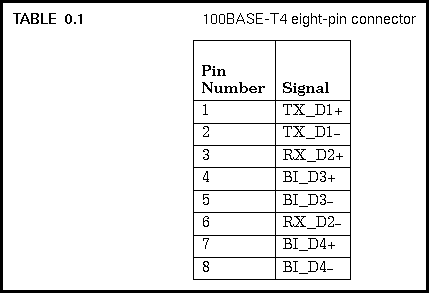
12.2 100BASE-T4 Components
Segments of 100BASE-T4 are limited to a maximum of 100 meters, to ensure that the round trip timing specifications are met. This is in contrast with the 10BASE-T media system, where the maximum segment length for the 10-Mbps link is mostly limited by signal strength. For example, if you use high quality twisted-pair cable in a 10-Mbps 10BASE-T segment, it's possible to reach segment lengths of around 150 meters with success. This is not true in the 100-Mbps Fast Ethernet system, where the segment length for twisted-pair segments is set at a maximum of 100 meters for signal timing reasons.
The EIA/TIA cabling standard recommends a segment length of 90 meters between the wire termination equipment in the wiring closet, and the wall plate in the office. This provides 10 meters of cable allowance to accommodate patch cables at each end of the link, signal losses in intermediate wire terminations on the link, etc.
There are twisted-pair Ethernet cable testers available that allow you to check the electrical characteristics of the cable you use, to see if it meets the important electrical specifications in the standard. These specifications include signal crosstalk, which is the amount of signal that crosses over between the receive and transmit pairs, and signal attenuation, which is the amount of signal loss encountered on the segment.
The 100BASE-T4 media system uses four pairs of wires, which requires that all eight pins of the eight-pin (RJ-45 style) MDI connector be used.
As shown in the table, of the four pairs, one pair is for transmit data (TX), one pair is for receive data (RX), and two are bidirectional data pairs (BI). Each pair is polarized, with one wire of the pair carrying the positive (+) signal, and the other wire of the pair carrying the negative (-) signal.
Generated with CERN WebMaker